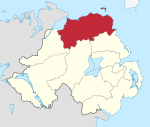Causeway Coast and Glens
Causeway Coast and Glens is a local government district covering most of the northern part of Northern Ireland. It was created on 1 April 2015 by merging the Borough of Ballymoney, the Borough of Coleraine, the Borough of Limavady and the District of Moyle. The local authority is Causeway Coast and Glens Borough Council.
Causeway Coast and Glens Irish: Cósta an Chlocháin agus na Gleannta Ulster Scots: Causey Coast an Glens | |
|---|---|
Borough | |
 | |
| Sovereign state | United Kingdom |
| Constituent country | Northern Ireland |
| Status | District |
| Incorporated | 1 April 2015 |
| Government | |
| • Type | Borough council |
| • Body | Causeway Coast and Glens District Council |
| Area | |
| • Total | 760 sq mi (1,980 km2) |
| Population (mid-2019 est.) | |
| • Total | 144,246 |
| • Density | 190/sq mi (73/km2) |
| Time zone | UTC0 (GMT) |
| • Summer (DST) | UTC+1 (BST) |
| Website | http://www.causewaycoastandglens.gov.uk/ |
Geography
The district covers most of the northern part of Northern Ireland; an area totalling 1796 km² spanning parts of Counties Antrim and Londonderry. It has a population of around 144,246[1]. The name of the new district was announced on 17 September 2008 as 'Causeway Coast' and was revised in February 2009.
Northern Ireland Railways stations
- Bellarena station
- Castlerock station
- Coleraine station
- Ballymoney
- University station
- Dhu Varren station
- Portrush station
Rail services
Northern Ireland Railways provides services on the Belfast-Derry railway line between Londonderry station in the west and east to Belfast Lanyon Place station and Belfast Great Victoria Street station.
The Coleraine-Portrush line provides a service from the interchange at Coleraine station at the south of the branch with Portrush station the station terminal at the north of the branch line.
Giant's Causeway and Bushmills Railway
The Giant's Causeway and Bushmills Railway is a heritage railway and major tourist attraction.
Coastal physical geography
The area stretches around from the River Roe near Bellarena on the shores of Lough Foyle, with Magilligan Point with Benone Strand on the Atlantic Ocean, and Mussenden Temple perched on the cliffs to Castlerock. At Castlerock the first of the seaside resorts the estuary of the River Bann is reached with crossing points located upstream at Coleraine. From the River Bann the coast includes seaside resorts of Portstewart and Portrush. Further along there is Dunluce Castle, Portballintrae and the town of Bushmills. Whilst Bushmills (home to the world's oldest licensed distillery which has produced the famous Irish whiskey "Bushmills" since 1608). The River Bush is crossed beside the Giant's Causeway and Bushmills Railway, and the Giant's Causeway is nearby. The next place are Ballintoy, and onwards to Ballycastle
The area is popular with tourists and includes some of the best-known physical features of Northern Ireland: the Giant's Causeway (a World Heritage Site), the Glens of Antrim and Rathlin Island, which lies 7 miles off Ballycastle. The coast includes Carrick-a-Rede Rope Bridge and the small Dunseverick Castle, and the more isolated seaside resort of Ballycastle, with a ferry to Rathlin Island across the Straits of Moyle. From Ballycastle the coastline veers southwards around Fair Head and continues with the North Channel and the settlements of Cushendun, then Cushendall and finally Waterfoot.
Causeway Coast and Glens District Council
Causeway Coast and Glens District Council replaced Ballymoney Borough Council, Coleraine Borough Council, Limavady Borough Council and Moyle District Council. The first election for the new district was originally due to take place in May 2009, but on April 25, 2008, Shaun Woodward, Secretary of State for Northern Ireland announced that the scheduled 2009 district council elections were to be postponed until 2011.[2] The first elections took place on 22 May 2014 and the council acted as a shadow authority until 1 April 2015.
Settlements
Towns and villages
See also
References
- "Population Estimates for UK, England and Wales, Scotland and Northern Ireland, Mid-2019". Office for National Statistics. 6 May 2020. Retrieved 6 May 2020.
- Northern Ireland elections are postponed, BBC News, April 25, 2008, accessed April 27, 2008